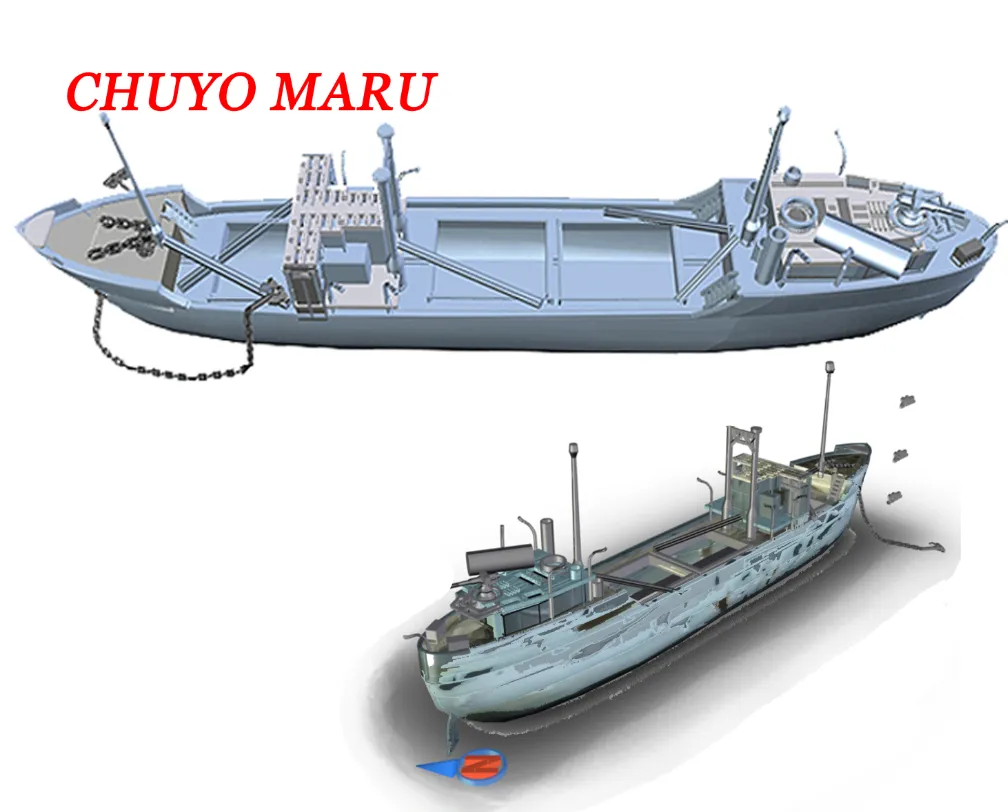Welcome to the Chuyo Maru, one of the most popular wrecks in Palau! This medium-sized coastal freighter was bombed during Operation DESCECRATE ONE on March 30-31, and she sank on April 1, 1944. Located in West Malakal Anchorage, just a five-minute boat ride from most dive shops in Koror, this wreck is a must-see for advanced divers with deep and wreck diving experience.
The Chuyo Maru is known as the Lion Fish Wreck for the large number of lionfish that reside in and on the ship. The wreck is resting upright at 120 feet (40 meters) of water, with the deck at 90 feet (30 meters) and the top of the forward tower at 35 feet (12 meters). Visibility can vary from 100 feet to 20 feet (33 to 7 meters), but divers almost always find better visibility on the forward half of the wreck.
The ship is 285 feet (89 meters) long, 40 feet (12.4 meters) wide, and had a tonnage of 1941 tons. Built in 1943 and owned by Toyo Kisen Kaisha, Tokyo, this costal freighter has a rich history. The Chuyo Maru has no marker buoy, so the dive guide will locate the wreck and use a lead weighted anchor to tie off the boat.
The dive usually begins at the bow section of the ship. The bow is raised above the main deck with a tall loading tower in the middle. On top of the forecastle is a large double-headed anchor winch and coils of cable now encrusted with colorful corals. On the port side of the deck, just prior to reaching the bridge, are two (2) anchors. In the early 1990s, a fishing boat unknowingly anchored above the Chuyo Maru, and while lifting their anchor, they snagged the Chuyo anchor. The chain from the fishing boat broke trying to lift both anchors. Both anchors can now be seen lying together on the deck. Square trussed loading beams from the forward mast extend aft toward the forward hold, which is now empty.

Swim aft toward the bridge. The bridge structures were burned during the bombing and have since disintegrated, but remains of the brass compass and ship's telegraph can still be seen. Swimming past the bridge, you will approach the main cargo holds, which are also empty. Save your air and bottom time for further exploration.
The engine room and boiler room are raised above the main boat deck, and preparation is needed to penetrate these areas. A single door on the starboard side leads to a catwalk and stairs that connect the deck to the engine room entrance. The engine room is relatively large but can turn into rusty-brown silt-filled water very quickly. Further aft, toward the stern past the engine room skylights, are the stern gun, four (4) ammunition boxes, and two (2) depth charge launchers, both containing a depth charge. The stern gun is a standard 1.86-ton gun with a short barrel and a maximum range of 17,388 feet (5300 meters). This type of gun was usually mounted on ships under 5000 tons.
There are no coral formations around the wreck, and the bottom is silt. However, the entire bow section is covered with hard corals, black corals (Antipathes sp.), and spiral corals. Look closely at these corals, and you may find a large number of translucent shrimps living on them. Cock's Comb oysters and soft corals cover the rails and deck. An area that is especially rich with lionfish is just past the cargo aft holds.
The usual abundance of colorful tropical fish can be found everywhere on the wreck, making it a vibrant and fascinating dive site.
However, it is essential to note that live ammunition can be found on this ship, as well as with all ship and plane wrecks in Palau waters. It is crucial not to pick up any ammunition, as due to the age of the bullets, bombs, and mortars, etc., these pieces of history are very unstable and can explode. Penetration dives are not recommended unless the diver is experienced and skilled, and due to the age of the ship and the silting conditions, penetration into this wreck is considered dangerous.
Interestingly, although the exact location of this wreck was recorded, the wreck was not considered worth salvaging after the war. She was forgotten until April of 1989 when wreck hunters Francis Toribiong and Klaus Lindemann rediscovered her.
In conclusion, the Chuyo Maru is a fascinating dive site in Palau, offering advanced divers with deep and wreck diving experience the opportunity to explore a well-preserved historical shipwreck. With lionfish and a variety of coral and marine life to discover, this dive is not one to be missed. However, caution must be taken when exploring the ship, as live ammunition can be found and penetration dives are dangerous.


